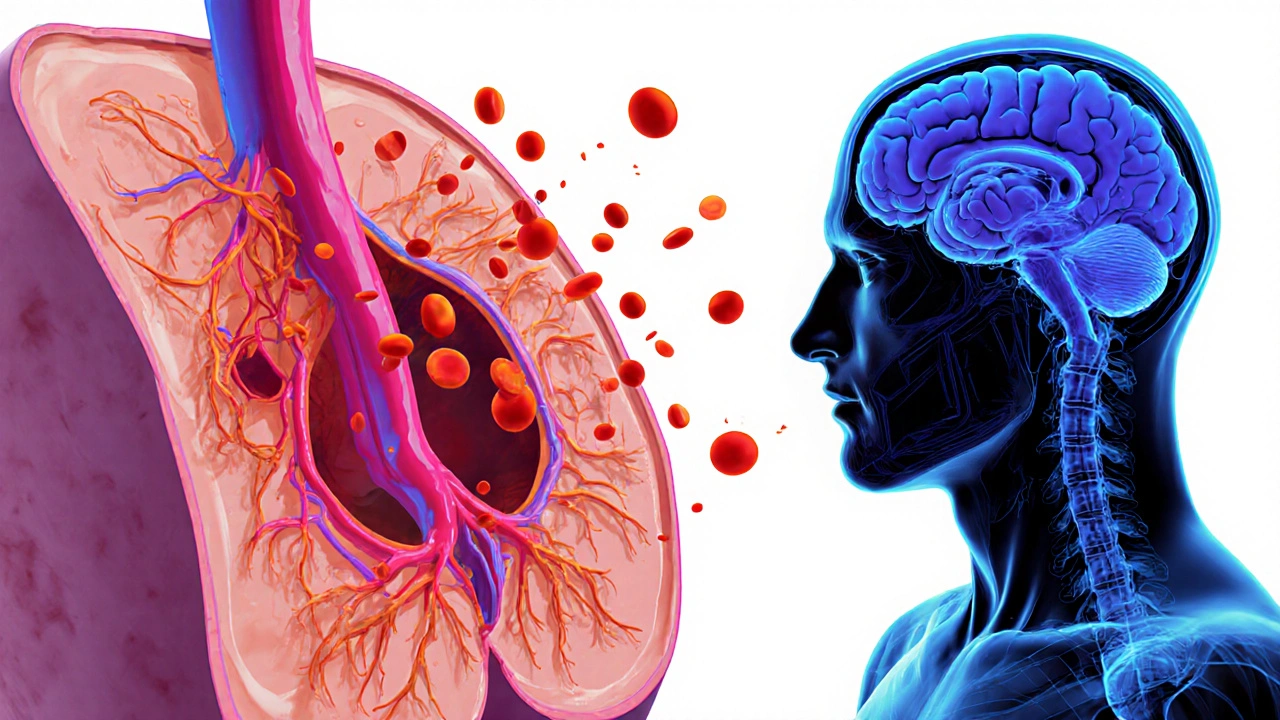Fibromyalgia vs. Autoimmune Disorder Symptom Checker
Select a symptom above and click "Check Symptom Overlap" to see how fibromyalgia and autoimmune disorders relate.
How This Helps
This tool illustrates the significant symptom overlap between fibromyalgia and autoimmune disorders, helping you understand why diagnosis can be complex. Both conditions involve immune dysfunction, central sensitization, and similar symptoms like fatigue and pain.
When you hear the word fibromyalgia, a picture of widespread aches and endless fatigue often pops up. Yet a growing body of research shows that this condition may share more than just symptoms with classic autoimmune disorders - it could be part of the same immune‑driven story.
What is Fibromyalgia?
Fibromyalgia is a chronic pain syndrome characterized by widespread musculoskeletal tenderness, sleep disturbances, and cognitive fog. The condition affects roughly 2‑4% of the population, with women accounting for about 80% of cases. Diagnosis relies on the 2016 American College of Rheumatology criteria, which focus on symptom severity and the number of painful tender points.
Understanding Autoimmune Disorders
Autoimmune disorders are a group of diseases where the immune system mistakenly attacks the body’s own tissues. Examples include rheumatoid arthritis, systemic lupus erythematosus, multiple sclerosis, and type 1 diabetes. Over 80 million Americans live with at least one autoimmune condition, and many experience chronic pain, fatigue, and mood changes-symptoms that overlap heavily with fibromyalgia.
The Immune System’s Role in Pain
At the heart of both fibromyalgia and autoimmune disorders lies the immune system. In a healthy state, the immune system distinguishes self from non‑self and coordinates healing. When this balance tilts, inflammatory molecules called cytokines flood the bloodstream, sensitizing nerves and altering pain processing pathways.

Central Sensitization: The Bridge Between Fibromyalgia and Autoimmunity
Central sensitization is a neuro‑physiological state where the spinal cord and brain amplify pain signals. Researchers have found that people with autoimmune diseases often show heightened central sensitization, and the same mechanism is a hallmark of fibromyalgia. Functional MRI studies from 2023 reveal increased activity in the insula and anterior cingulate cortex of both patient groups, suggesting a shared neural pathway.
Overlap in Symptoms and Biomarkers
Beyond pain, fibromyalgia patients frequently report fatigue, sleep problems, and mood swings-symptoms that are also core features of many autoimmune disorders. A 2022 systematic review identified elevated levels of interleukin‑6 (IL‑6) and tumor necrosis factor‑alpha (TNF‑α) in a majority of fibromyalgia cohorts, mirroring the cytokine profiles seen in rheumatoid arthritis and lupus.
| Feature | Fibromyalgia | Autoimmune Disorders (e.g., RA, SLE) |
|---|---|---|
| Widespread Pain | ✔︎ | ✔︎ (joint‑specific) |
| Fatigue | ✔︎ | ✔︎ |
| Sleep Disturbances | ✔︎ | ✖︎ (often secondary) |
| Elevated IL‑6 | ✔︎ (moderate) | ✔︎ (high) |
| Positive Autoantibodies | ✖︎ (rare) | ✔︎ (RF, ANA, etc.) |
Key Autoimmune Conditions Frequently Studied with Fibromyalgia
- Rheumatoid arthritis - joint inflammation, high CRP, often co‑exists with fibromyalgia, complicating pain assessment.
- Systemic lupus erythematosus - multisystem autoimmunity, skin rash, and musculoskeletal pain that may be mistaken for fibromyalgia flare.
- Hashimoto’s thyroiditis - autoimmune thyroid disease that can cause muscle aches and fatigue, overlapping with fibromyalgia’s symptom set.
Why the Link Matters for Diagnosis
Doctors often struggle to differentiate pure fibromyalgia from an underlying autoimmune disease because the clinical picture blurs. Missing an autoimmune diagnosis can delay disease‑modifying therapy, while labeling an autoimmune patient as “just fibromyalgia” may lead to inadequate pain control.
Practical tips for clinicians:
- Order basic autoimmune panels (ANA, RF, anti‑CCP) when patients present with unexplained fatigue and pain.
- Use tender‑point counts alongside imaging (ultrasound for synovitis) to spot joint inflammation.
- Consider referral to a rheumatologist if cytokine markers (IL‑6, TNF‑α) are markedly elevated.

Treatment Overlap and Divergence
Because both conditions involve the immune system, some therapies cross over. Low‑dose naltrexone, originally used for autoimmune pain, has shown modest benefit in fibromyalgia trials. Conversely, biologics like etanercept, which target TNF‑α, improve rheumatoid arthritis pain but have limited evidence in standalone fibromyalgia.
Non‑pharmacologic strategies work for both:
- Exercise (graded aerobic activity) reduces cytokine levels and improves pain thresholds.
- Cognitive‑behavioral therapy helps re‑wire central sensitization pathways.
- Sleep hygiene-consistent bedtime, dark room-lowers nocturnal cortisol spikes that fuel inflammation.
Current Research Gaps
While dozens of studies link fibromyalgia to immune dysregulation, few have established a causal direction. Is chronic pain driving immune activation, or does a subtle autoimmune process spark the pain? Large‑scale longitudinal cohorts, such as the 2024 Fibro‑Autoimmune Registry, aim to answer this by tracking cytokine trends before and after symptom onset.
Another unanswered question is the role of genetics. Genome‑wide association studies hint at shared HLA‑DRB1 alleles between fibromyalgia and certain autoimmune diseases, but replication is needed.
Practical Takeaways for Patients
If you’ve been diagnosed with fibromyalgia, keep an eye on any new joint swelling, skin rashes, or unusual blood test results. Bring these observations to your doctor-early detection of an autoimmune condition can change the treatment plan dramatically.
Conversely, if you live with an autoimmune disease and notice widespread muscle soreness that doesn’t follow joint patterns, ask about a fibromyalgia assessment. Managing both conditions often means a blended approach: disease‑modifying drugs for the autoimmunity plus pain‑focused therapies for fibromyalgia.
Frequently Asked Questions
Can fibromyalgia be classified as an autoimmune disease?
Most experts agree that fibromyalgia is not an autoimmune disease because it lacks specific autoantibodies and organ‑targeted inflammation. However, the condition shares immune‑related mechanisms, such as elevated cytokines and central sensitization, which blur the lines.
What tests can reveal an underlying autoimmune disorder in a fibromyalgia patient?
Basic labs include antinuclear antibody (ANA), rheumatoid factor (RF), anti‑CCP, thyroid panel, and inflammatory markers (CRP, ESR). Positive results warrant a referral to a rheumatologist for further imaging and specialist evaluation.
Do medications for autoimmune diseases help with fibromyalgia pain?
Some immune‑targeting drugs, like low‑dose naltrexone or certain SNRIs, have modest effects on fibromyalgia pain. Classic biologics (e.g., TNF inhibitors) are effective for joint inflammation but have not consistently reduced fibromyalgia‑type widespread pain.
Is lifestyle change enough to manage both conditions?
Lifestyle interventions-regular low‑impact exercise, balanced diet, stress reduction, and good sleep-are foundational for both fibromyalgia and autoimmune disorders. They can lower cytokine levels and improve overall quality of life, but many patients still need medication to control disease activity.
What future research might clarify the connection?
Longitudinal cohort studies tracking immune markers from pre‑symptom stages, combined with genetic analyses, are the most promising. Imaging studies that map brain pain circuitry in autoimmune patients who develop fibromyalgia will also shed light on causality.







